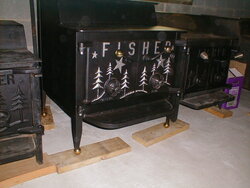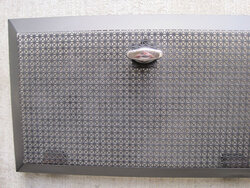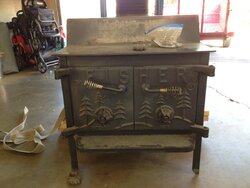Last edited by a moderator:
Verifying year and Model of Fisher Stove
- Thread starter ML1911A1
- Start date
-
Active since 1995, Hearth.com is THE place on the internet for free information and advice about wood stoves, pellet stoves and other energy saving equipment.
We strive to provide opinions, articles, discussions and history related to Hearth Products and in a more general sense, energy issues.
We promote the EFFICIENT, RESPONSIBLE, CLEAN and SAFE use of all fuels, whether renewable or fossil.
You are using an out of date browser. It may not display this or other websites correctly.
You should upgrade or use an alternative browser.
You should upgrade or use an alternative browser.
Thanks Coaly for the info. Also I want to refurbish the stove before I install it. I've done some reading up on the my stove. I do not install door gaskets correct ? The round stock is the door seal ? Also if I wanted to replace the door handle springs with new ones, would you recommend a brand and type ? Thanks again.Yes it is.
Unfortunately the original stainless steel door handle springs were replaced with newer plated springs and the feet didn't exist when it was built. It should come with a black fire screen instead of feet.
No gasket material.
Handle springs from Woodman's Parts Plus is # RH-LDN
With pliers, latch onto the last coil at end of spring and rotate your old ones off. This will loosen spring as you turn.
Simply screw new ones on by hand (opens spring as you turn spring down handle)
Handle springs from Woodman's Parts Plus is # RH-LDN
With pliers, latch onto the last coil at end of spring and rotate your old ones off. This will loosen spring as you turn.
Simply screw new ones on by hand (opens spring as you turn spring down handle)
The stove didn't come with a screen. I'll probably end up making one, if I can't find one. So that stove did not come with feet originally ? Thanks again for the info. I'll post a pic when I am done with clean up and paint
No, the early stoves had chrome balls that were adjustable with a set screw for uneven surface. Later the straight facing feet were made of cast iron finished with Black Oxide or chrome plated. Later they were plated with white brass. Even later they were cast angled with white metal (sometimes called pot metal which is not ferrous so is not magnetic) they were also plated with white brass. (yours) Your legs are also supposed to be tapered as per the original drawings but some fabricators did not taper, and cut them straight or an angled tip like yours. When angled properly, the feet don't fit and look right. The feet also came with washers to stack inside them to level stove. They are stove levelers, not just for looks. If yours doesn't have steel rod welded to the legs or nuts welded inside legs to screw threaded rod into, it never had the chrome ball feet. The owner probably saw them as an accessory years later at a Fisher Factory Showroom and added them to their stove. They were cheap selling for 2.50 black, 3.50 plated and now a mint set can sell for $50 to $100 EACH. You'll find people selling them in rough condition, or even painted asking for the same amount as new condition. Perhaps they don't know what new looked like.......

This is the time period correct screen;
 They do show up on eBay from time to time, but be prepared to pay. They can go into the hundreds, as well as the feet. The feet OR screen can easily be worth more than the stove.
They do show up on eBay from time to time, but be prepared to pay. They can go into the hundreds, as well as the feet. The feet OR screen can easily be worth more than the stove.
The '76 Grandpa pictured above is more of a prototype than the mass produced version. It has a 3 piece welded top, brass handles and brass ball feet. The doors were painted black with no highlighting.

This is the time period correct screen;
 They do show up on eBay from time to time, but be prepared to pay. They can go into the hundreds, as well as the feet. The feet OR screen can easily be worth more than the stove.
They do show up on eBay from time to time, but be prepared to pay. They can go into the hundreds, as well as the feet. The feet OR screen can easily be worth more than the stove.The '76 Grandpa pictured above is more of a prototype than the mass produced version. It has a 3 piece welded top, brass handles and brass ball feet. The doors were painted black with no highlighting.
No, the early stoves had chrome balls that were adjustable with a set screw for uneven surface. Later the straight facing feet were made of cast iron finished with Black Oxide or chrome plated. Later they were plated with white brass. Even later they were cast angled with white metal (sometimes called pot metal which is not ferrous so is not magnetic) they were also plated with white brass. (yours) Your legs are also supposed to be tapered as per the original drawings but some fabricators did not taper, and cut them straight or an angled tip like yours. When angled properly, the feet don't fit and look right. The feet also came with washers to stack inside them to level stove. They are stove levelers, not just for looks. If yours doesn't have steel rod welded to the legs or nuts welded inside legs to screw threaded rod into, it never had the chrome ball feet. The owner probably saw them as an accessory years later at a Fisher Factory Showroom and added them to their stove. They were cheap selling for 2.50 black, 3.50 plated and now a mint set can sell for $50 to $100 EACH. You'll find people selling them in rough condition, or even painted asking for the same amount as new condition. Perhaps they don't know what new looked like.......
View attachment 201255
This is the time period correct screen;
View attachment 201257 They do show up on eBay from time to time, but be prepared to pay. They can go into the hundreds, as well as the feet. The feet OR screen can easily be worth more than the stove.
The '76 Grandpa pictured above is more of a prototype than the mass produced version. It has a 3 piece welded top, brass handles and brass ball feet. The doors were painted black with no highlighting.
Thanks again Coaly for the info. Were Fisher stoves originally painted in a matte black or a satin ? Also when I open the right door, the spring slightly hits the other door handle. Is it supposed to do that, or do I need to slightly bend the right handle? Thanks
Satin Black is closest to original. Forrest Paints were used, now branded Stove Bright. Very good high temp paint that holds its color well but smells really bad like industrial paint when applied. It is best to paint outside and fire with a piece of pipe on the stove to cure paint and smoke it off before installing inside.
No, the handles should miss each other if you leave left door closed and rotate right handle. (many doors have a stop built in to prevent rotating handle farther than necessary- it is like a peg that sticks out of the back of door which yours won't have) Your old springs are too screwed up to test before bending handles to the correct position. You have the long, straight handles which are normally 4 inches from bend to original spring. (the newer plated springs they make now may screw down the handle a bit farther than original stainless tightly wound springs) There should be about 3 inches from handle rod to face of door at 4 inches from bend. (3 1/4 to center of rod at 4 inches from beginning of bend radius). The right spring should miss the left handle rod by about 1/2 inch when rotated with left door closed. If worn and sloppy, you can make them touch if you try. Not a big deal since when the latch is tight, the washer outside should seal the hole in door around loose fitting rod.
Your picture in the first post shows the right handle out of adjustment. The angle should be the same as the stationary left handle when latched.
This comes from people over tightening the door latch rod. If the door seal is kept clean as well as the inside of both doors, little downward pressure is required to seal. A wire wheel in drill is good for cleaning the door seal iron and the 3 door contact surface areas. Clean to bare metal before adjusting handle.
Heat the latch handle rod where bent inside the door with torch. You can get it hot enough with propane, then bend to a sharper 90* angle until the right handle is at the same angle when closed as the left door. It doesn't take much. They bend easily, but if you do it cold with a pipe or adjustable wrench it will go back when heated.
No, the handles should miss each other if you leave left door closed and rotate right handle. (many doors have a stop built in to prevent rotating handle farther than necessary- it is like a peg that sticks out of the back of door which yours won't have) Your old springs are too screwed up to test before bending handles to the correct position. You have the long, straight handles which are normally 4 inches from bend to original spring. (the newer plated springs they make now may screw down the handle a bit farther than original stainless tightly wound springs) There should be about 3 inches from handle rod to face of door at 4 inches from bend. (3 1/4 to center of rod at 4 inches from beginning of bend radius). The right spring should miss the left handle rod by about 1/2 inch when rotated with left door closed. If worn and sloppy, you can make them touch if you try. Not a big deal since when the latch is tight, the washer outside should seal the hole in door around loose fitting rod.
Your picture in the first post shows the right handle out of adjustment. The angle should be the same as the stationary left handle when latched.
This comes from people over tightening the door latch rod. If the door seal is kept clean as well as the inside of both doors, little downward pressure is required to seal. A wire wheel in drill is good for cleaning the door seal iron and the 3 door contact surface areas. Clean to bare metal before adjusting handle.
Heat the latch handle rod where bent inside the door with torch. You can get it hot enough with propane, then bend to a sharper 90* angle until the right handle is at the same angle when closed as the left door. It doesn't take much. They bend easily, but if you do it cold with a pipe or adjustable wrench it will go back when heated.
Similar threads
- Replies
- 5
- Views
- 662
- Replies
- 8
- Views
- 2K
- Replies
- 2
- Views
- 866
- Replies
- 3
- Views
- 924


